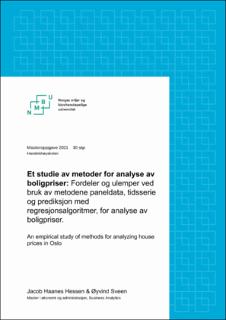| dc.contributor.advisor | Romstad, Eirik | |
| dc.contributor.author | Sveen, Øyvind | |
| dc.contributor.author | Hessen, Jacob Haanes | |
| dc.coverage.spatial | Norway, Oslo | en_US |
| dc.date.accessioned | 2022-01-12T09:40:06Z | |
| dc.date.available | 2022-01-12T09:40:06Z | |
| dc.date.issued | 2021 | |
| dc.identifier.uri | https://hdl.handle.net/11250/2837044 | |
| dc.description.abstract | Denne masteroppgaven undersøker tre forskjellige metoder for boligprisanalyse, der formålet er å utforske metodenes fordeler og ulemper. Da boligprisene i Oslo har steget mye og gjort det vanskelig for førstegangskjøpere å innta markedet, bruker studien typiske førstegangskjøperboliger som avgrensing i analysene. Metodene vi bruker er paneldataanalyse, tidsrekkeanalyse og prediksjon med regresjonsalgoritmer i maskinlæring. Alle analysene bruker et datasett med boligtransaksjoner i Oslo fra 2010-2020, som også inneholder attributter som beskriver hver solgte bolig.
I paneldataanalysen bruker vi en fast effekt-modell, som analyserer månedlig gjennomsnittlig kvadratmeterpris for Oslos 15 bydeler. Med få og nøye utvalgte uavhengige variabler kan vi trekke frem hvordan disse har en fast effekt på gjennomsnittlig kvadratmeterpris. Resultatene viser at økning i boliglånsrenten har en effekt som reduserer kvadratmeterprisen. Videre ser vi at antall kvadratmeter har en negativ effekt, som vil si at man betaler mer per kvadratmeter for mindre boliger. Vi ser også at betydningen av å ha et adskilt soverom i førstegangskjøperboliger, hever kvadratmeterprisen.
I tidsrekkeanalysen tester vi ut en SARIMA-modell, som predikerer gjennomsnittlig kvadratmeterpris i Oslo aggregert på månedsnivå. Her tester vi ut to modeller som predikerer på data vi allerede har. Resultatene her gir lovende resultater som vi videre bruker i en prognosemodell. Prognosen vi lager er på 1,5 år frem i tid, og viser at kvadratmeterprisene kommer til å øke mye. SARIMA-modellen vår gir gode resultater, men har svakheter når det kommer til starttidspunkt for prediksjon. Modellen ser ut til å følge trenden til datapunktene rundt starttidspunktet. Til sist ser vi på hvordan maskinlæring kan benyttes til å predikere boligpriser ved hjelp av tre-baserte regresjonsalgoritmer. Her ser vi på hvor nærme faktisk kvadratmeterpris modellen estimerer, gitt ett utvalg variabler som beskriver hver boligenhet samt boliglånsrente. Vi tester modellene Decision Trees, Random Forest og Extreme Gradient Boosting. Her oppnår sistnevnte best resultater med en RMSE på 3561,03. Videre benytter vi modellens funksjon som heter «Feature Importance» som et forsøk i å forklare hvordan modellen vekter variablene i prediksjonen. Hovedkonklusjonen fra denne studien er at metodene har både fordeler og ulemper. Metodene er vanskelige å sammenligne da de har forskjellige formål, men samlet belyser de ulike deler som er nyttige for førstegangskjøpere på jakt etter bolig. | en_US |
| dc.description.abstract | This thesis investigates three different methods for analyzing house prices. The aim is to explore which pros and cons the methods have, and how they contribute to analyzing the real estate market in Oslo. House prices has grown rapidly the ten last years, and smaller dwellings for a typical first-time buyer have become far more expensive than most can afford. Therefore, this thesis uses typical first-time buyer dwellings as a limitation in the analysis. The methods used are fixed effects in a panel data analysis, the univariate timeseries model SARIMA, and prediction with the machine learning algorithms Decision Trees, Random Forest and Extreme Gradient Boosting. The three analysis methods use a dataset of transacted properties in Oslo form 2010-2020. The dataset contains attributes which describes each unit sold.
The fixed effects-model in panel data has an advantage in explaining why the average square meter prices varies. The panel data analysis investigates the 15 districts of Oslo as crosssections and months as the time series. Results here show that an increase in mortgage rate, reduce the average square meter price and vice versa. Further on the analysis shows that smaller dwellings have a higher price per square meter, and that having a bedroom increases the square meter price.
The time-series analysis with SARIMA makes two predictions with in-sample data that produces promising results which we use in an out of-sample forecast 1,5 years ahead in time. The results shows that the SARIMA-model can produce good predictions, but that the model has weaknesses when it comes to the starting point of the prediction. If the datapoints around the starting point has a clear trend the models seem to follow this trend.
In the machine learning analysis, we predict the actual square meter price based on each dwelling´s attributes and the mortgage rate at the selling point. The XGBoost algorithm produced the best prediction with an RMSE of 3561,03. Further on we use XGBoost feature importance in an attempt to understand how the model weights the attributes in its predictions.
The main conclusion drawn from this thesis is that each method has its pros and cons. The panel data analysis is useful in explaining what causes price differences. The time-series analysis is useful in forecasting prices in the future and understanding historical and seasonal variations of the price. And the prediction with machine learning is useful in predicting house prices with high precision but lacks insight in how and why the variables influence the price. The methods cannot be compared directly because of their different perspectives, but all their purposes are all useful for first-time buyers. | en_US |
| dc.language.iso | nob | en_US |
| dc.publisher | Norwegian University of Life Sciences, Ås | en_US |
| dc.rights | Attribution-NonCommercial-NoDerivatives 4.0 Internasjonal | * |
| dc.rights.uri | http://creativecommons.org/licenses/by-nc-nd/4.0/deed.no | * |
| dc.subject | Property | en_US |
| dc.subject | House prices | en_US |
| dc.title | Et studie av metoder for analyse av boligpriser : fordeler og ulemper ved bruk av metodene paneldata, tidsserie og prediksjon med regresjonsalgoritmer, for analyse av boligpriser | en_US |
| dc.title.alternative | An empirical study of methods for analyzing house prices in Oslo | en_US |
| dc.type | Master thesis | en_US |
| dc.description.localcode | M-ØA | en_US |

